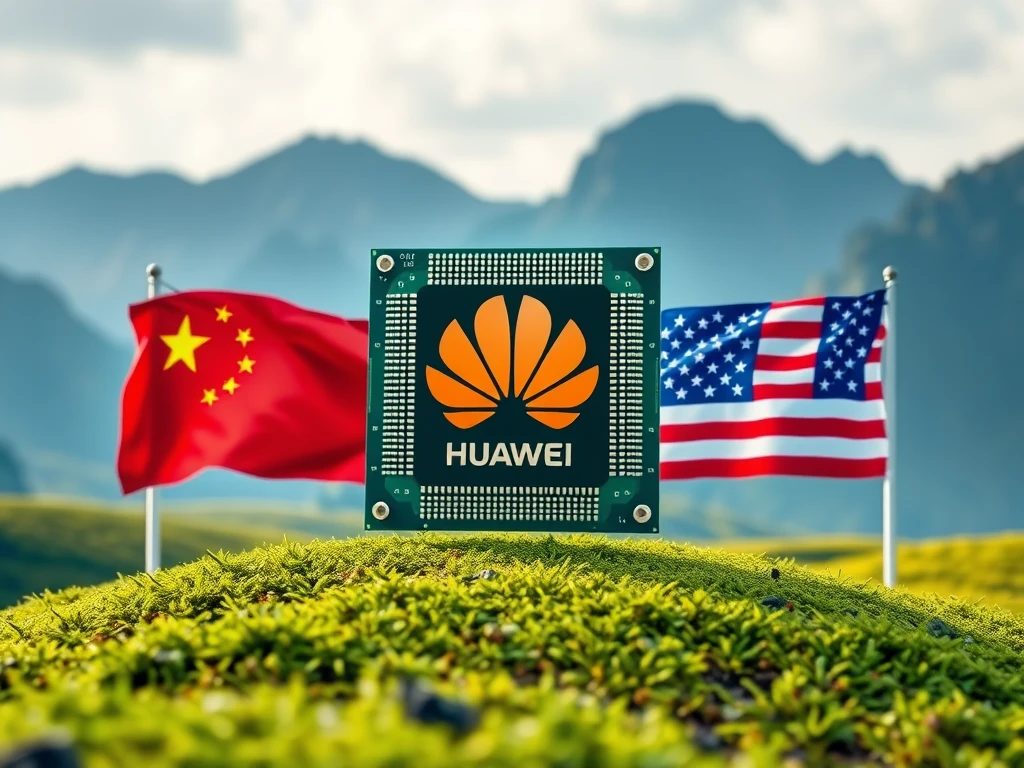Huawei AI Chip: China’s Bold Bid to Challenge Nvidia Revealed

In the fast-paced world of technology, where innovation drives market shifts that can even ripple into areas like cryptocurrency infrastructure and investment, the race for advanced computing power is heating up. A significant development on this front involves the potential emergence of a formidable competitor to a key player in the AI space. Get ready to hear about the new Huawei AI chip making waves.
Huawei AI Chip: A New Challenger Emerges
Chinese tech giant Huawei is reportedly making significant strides in developing powerful artificial intelligence processors. Sources indicate that Huawei is preparing to test a new AI chip, the Ascend 910D. This move positions Huawei to potentially challenge the dominance of US chip maker Nvidia in the high-end AI chip market.
The Wall Street Journal reported that Huawei has approached Chinese tech firms to begin testing this latest chip. The first samples are expected to reach these partners by late May. While still in early development, these tests are crucial for assessing the chip’s capabilities and preparing it for wider customer adoption.
Aiming to Be an Nvidia Rival
Huawei is setting ambitious targets for its new Ascend AI processor. The company hopes the Ascend 910D will surpass the performance of Nvidia’s H100 chip, a key processor used for AI training in 2022. This ambition highlights the intensity of the competition in the global AI hardware market.
Beyond the new 910D, Huawei is also scaling up production of its existing Ascend series chips. Reports suggest the company plans to ship over 800,000 of the earlier Ascend 910B and 910C models to customers. These customers include major state-owned telecom operators and private AI developers within China, such as ByteDance, the parent company of TikTok.
The Impact of US Export Restrictions
This push by Huawei occurs within a complex geopolitical landscape marked by escalating trade tensions between China and the US. The US government has imposed significant export restrictions on advanced semiconductors and related technology to China. These restrictions have directly impacted companies like Nvidia.
In mid-April, Nvidia disclosed that it anticipates substantial charges related to its AI chip inventory due to these export limitations affecting its business in China. The US has added several Nvidia processors, including the H20 (designed for the Chinese market), to its restricted list. Furthermore, restrictions also cover essential components for AI chips, such as high-bandwidth memory units.
Beijing has responded by encouraging domestic AI developers to prioritize purchasing chips made within China. This policy aims to increase self-reliance in critical technology sectors.
China AI: Pushing for Self-Reliance
The drive for domestic chip development aligns with China’s broader national strategy. State media recently reported that Chinese President Xi Jinping emphasized the importance of “self-reliance and self-strengthening” in developing AI technology. During a Politburo meeting study session, Xi reportedly stated the need to “comprehensively advance technological innovation, industrial development, and AI-empowered applications.”
He further stressed the necessity to “strengthen basic research, concentrate our efforts on mastering core technologies such as high-end chips and basic software, and build an independent, controllable, and collaborative artificial intelligence basic software and hardware system.” This highlights a clear government mandate behind efforts like Huawei’s AI chip development.
What Does the Ascend 910D Mean?
The development of the Ascend 910D is a direct response to both market demand and geopolitical pressures. While the full capabilities are still under wraps and require testing, its potential to rival high-end Nvidia chips is significant. Huawei is also focusing on system-level innovation, as seen with its CloudMatrix 384 computing system. This system connects Ascend 910C chips, leveraging chip arrays and brute force processing power rather than solely relying on individual chip performance boosts.
This approach suggests Huawei is not just building individual chips but also developing the integrated systems needed for large-scale AI training and deployment, a crucial step in competing effectively with established players.
Challenges and the Path Forward
Developing a chip capable of truly competing with market leaders like Nvidia is a complex process. Huawei faces technical challenges in manufacturing and performance optimization. Furthermore, the ongoing US export restrictions continue to pose potential hurdles, impacting access to certain manufacturing technologies or components, even for domestic production.
The testing phase for the Ascend 910D is critical. Its success will depend on its actual performance in real-world AI workloads and its ability to integrate seamlessly into developers’ existing systems. The geopolitical climate adds another layer of complexity, influencing supply chains and market access.
Summary
Huawei’s reported testing of the new Huawei AI chip, the Ascend 910D, marks a notable step in China’s push for technological self-sufficiency and its ambition to compete with global leaders like Nvidia. Driven by both market demand and the strategic goal of overcoming US export restrictions, this development signifies the intense global race in AI hardware. While challenges remain, particularly in performance validation and navigating trade barriers, the emergence of the Ascend 910D underscores China’s commitment to building a robust domestic AI ecosystem capable of challenging established players and fostering its own AI advancements.









